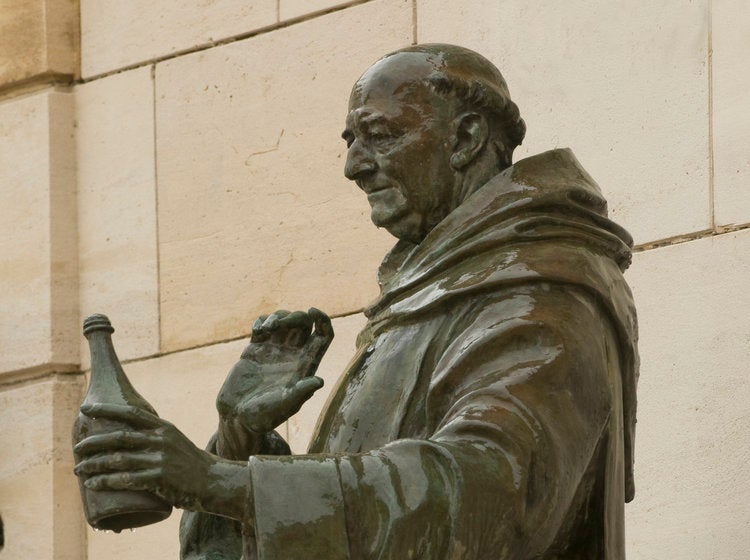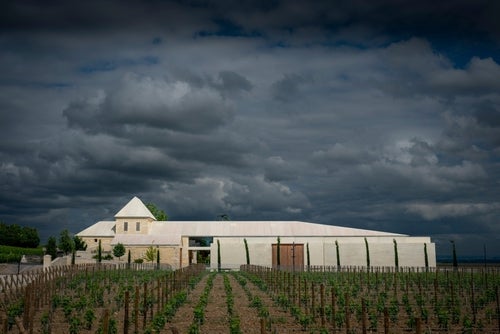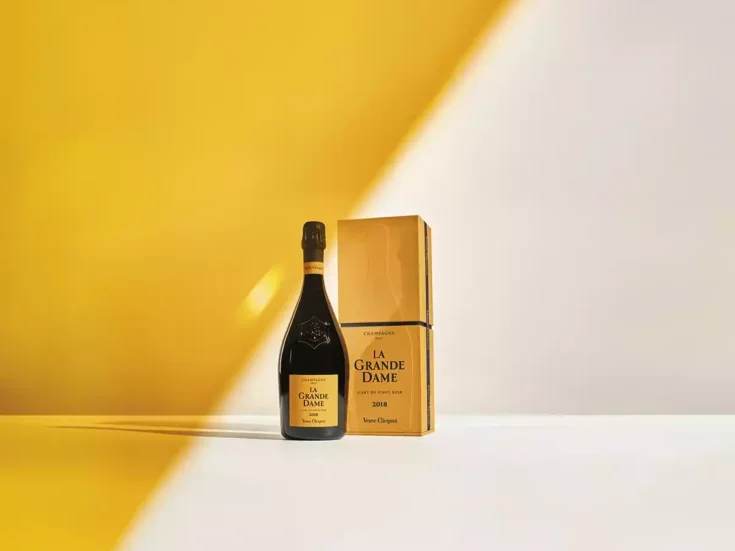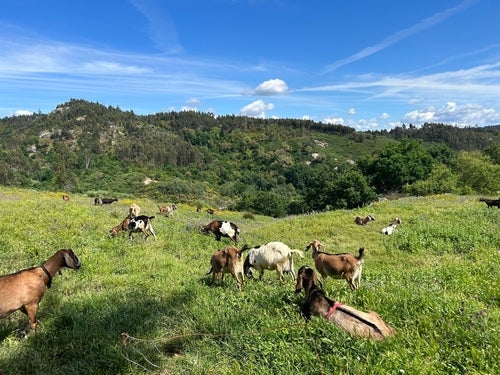
It was Dom Grossard, the last cellar master at the Benedictine Abbey of Hautvillers, who started the persistent rumor that one of his predecessors, Dom Pérignon, had invented Champagne. In a letter to the deputy mayor of Aÿ, he wrote: “As you know, Monsieur, it was the celebrated Dom Pérignon who found the secret of making white sparkling wine.” But of course that was more than a century after Dom Pérignon’s death. Grossard did not know Dom Pérignon, whereas his successor Frère Pierre did. In 1724, just nine years after the death of his mentor, Frère Pierre wrote a 35-chapter treatise called Traité de la Culture des Vignes de Champagne, which fastidiously recorded Dom Pérignon’s achievements, practices, and working principles. Yet nowhere in this detailed document can we find any mention of sparkling Champagne, let alone the slightest hint that it had been invented by the modern world’s most famous Benedictine monk.
Although Dom Pérignon is still occasionally and erroneously credited in the popular press as the inventor of Champagne, no well-researched writer or historian today believes Grossard’s fabrication. Not even Moët & Chandon now attempts to hoodwink the public. Certainly not Richard Geoffroy, the cellar master of Champagne Dom Pérignon, who is quite content to let the great man’s reputation rest on his true accomplishments and to emulate his quest to produce one of the greatest wines in the world. As some vintages of Dom Pérignon clearly demonstrate, Geoffroy and a few of his predecessors have been remarkably successful in achieving just that.
Origin of Cuvée Dom Pérignon
The Dom Pérignon brand was originally owned by Champagne Mercier, but it had never been used, and it came into Moët’s possession as part of Francine Durand-Mercier’s dowry when she married Comte Paul Chandon-Moët in 1927. Curiously, the first vintage of Dom Pérignon was 1921, harvested six years prior to the acquisition of the brand.

Photography by Jon Wyand
It gets more curious. The 1921 was shipped in 1936, but one year earlier another Champagne was shipped in an identical replica 18th-century bottle, and it had the same classic shield-shaped label, right down to Deletain’s motif of vine shoots and grape bunches running up both sides. The vintage was 1926, and despite looking exactly like the Dom Pérignon that would be shipped a year later, there was no mention of the Dom Pérignon name, just “Champagne specially shipped for Simon Brothers & Co’s Centenary 1835-1935.” Simon Brothers was then Moët & Chandon’s London agent, and two bottles of this Champagne were sent in a picnic hamper to 150 of its best customers, which included the elite of British society. Some of these bottles were shared with American friends, and word quickly filtered across the Atlantic. Moët & Chandon soon found itself inundated with demands for this very special Champagne to be commercially available in the States, which is why 100 cases of the 1921 vintage were shipped to New York in 1936. These bottles could not bear the Simon Brothers name, of course, so a new brand had to be created, and it was Moët’s marketing director (later to become chairman) Comte Robert-Jean de Vogüé who decided to name it after the legendary Dom Pérignon. It was also a nice touch that he chose the 1921 vintage, which was a much greater year than 1926, making the Americans feel more important, rather than just an afterthought. That is how we end up with the younger 1926 being released before the more mature 1921. The Simon Brothers’ Centenary Cuvée was not the first Dom Pérignon, but it was clearly the precursor to Dom Pérignon.
My assertion that the first vintages of Dom Pérignon (1921, 1928, 1929, and possibly 1934) were transvasaged is something that has always intrigued today’s cellar master. Although Geoffroy has never overtly agreed with me on this point, he has also never been able to counter the logic of the transvasage argument. The crux of the matter is all in the timing. Dom Pérignon 1921 was not only the first vintage of Dom Pérignon, it was also the very first prestige cuvée to be commercialized. The notion of a prestige cuvée was not conceived until 1932, when it was proposed by Laurence Venn, an English journalist and the UK marketing consultant to the Syndicat de Grandes Marques de Champagne. The Great Depression hit the UK in 1929 but did not begin to affect the French economy until 1931. Between these two dates, all the great Champagne brands reacted to falling sales by slashing prices and, to maintain at least some profit, by cutting costs, but sales and prices plummeted at such a rate that no amount of costcutting could stop the losses. Houses went broke or sold off vineyards, and not a few blamed their London agents, firing them in the process. At a meeting of the syndicat in 1932, when Venn was asked how Champagne houses could revitalize sales in the UK, he proposed the production of a luxury cuvée. He said it must be of exceptional quality, sold in a replica of an original 18th century Champagne bottle, and should cost more than twice the price of the most expensive Vintage Champagne ever sold. They thought he was mad. How could they be expected to sell a luxury cuvée at an unprecedented high price when houses could not even sell cut-price Champagne? Venn pointed out that this could be achieved by targeting the British aristocracy, one of the few sectors of the market capable of such extravagances during hard times. This advice was soundly rejected by almost everyone in the syndicat. Just one person did not think that Venn was mad, and that was Robert-Jeande Vogüé of Moët & Chandon. He took Venn to dinner that evening and picked his brains — and within three years, 300 replica 18th-century bottles of Champagne were winging their way to 150 of Simon Brothers’ best customers. It is no coincidence that the recipients were mostly members of the British aristocracy or that this promotional exercise generated a commercial demand for Champagne of an unprecedented quality and price — albeit from the opposite side of the Atlantic than had been anticipated.
From the above sequence of events, it is clear to see that the bottle did not come first; the vintages did. The idea of replicating an 18th-century bottle was not even discussed until 1932 and did not make its debut until 1935, long after the first vintages of 1921, 1928, and 1929. It is just possible that the 1934 was fermented in the replica bottle in which it was sold but not really likely, since that would have taken place two years before the Simon Brothers Centenary Cuvée had generated any demand for a fully commercial prestige cuvée. Even the 1943 is dubious. Would they bother in the middle of a world war? Would a replica 18th-century Champagne bottle even be available under such circumstances? Or did they leave it until after the war and transvasage it like the rest? The logic of the transvasage argument is hard to deny, particularly for the first three vintages, but could easily be disproved by an invoice supplying Moët with replica 18th-century Champagne bottles 11 years before Venn’s radical proposal (which is on record in the archives of the Syndicat de Grandes Marques de Champagne). Such documentary evidence has yet to materialize. Nor would there have been anything wrong with the early Dom Pérignon vintage being transvasaged; it would have been a necessity of the time.
Dom Pérignon deconstructed
Mapping a mosaic of Dom Pérignon vineyards is not easy, because Moët never reveals the whole picture. But by carefully piecing together information gleaned from various sources at this house over the past 30 years or so, it has been possible to create a fairly accurate representation of the full range of sources available to Geoffroy at the time of assemblage. The old company line was, logically enough, that Dom Pérignon was produced exclusively from the vineyards belonging to the Abbey of Hautvillers when it was purchased by Pierre-Gabriel Chandon in 1823. When I was doing research for Christie’s World Encyclopedia of Champagne & Sparkling Wine, Moët gave me a list of the most important lieux-dits that accompanied the sale of Hautvillers. Some were attributed to the wrong villages, but that was easily resolved, and I have since compiled the following far more complete list of lieux-dits using, primarily, Naissance du Champagne (René Gandilhon, 1968) and Histoire de l’Abbaye et du Village d’Hautvillers (Abbé Manceaux,1880):
Grands crus
Aÿ-Champagne: [1] Côte d’Aÿ,
[2] Vauzelles
Ambonnay: [3] les Assises (most),
[4] les Dames (most)
Bouzy: [3] les Assises (part),
[5] les Brousses, [4] les Dames (part),
[6] les Pertes
Chouilly: [7] le Mont Aigu
Cramant: [8] les Buissons, [9] les
Busons, [10] les Payennes, [11] Saran
Mesnil-sur Oger: [12] Joyettes,
[13] les Moulins
Verzenay: [14] les Chardonnières,
[15] les Croix Rouges
Premiers crus
Cumières: [16] Barillets, [17] Clos
Sainte-Hélène, [18] les Côtes-a-Bras
Hautvillers: [19] les Basses Prières,
[20] les Chantes de Linotte,
[21] Côtes-de-Lhéry, [22] les Hautes
Prières, [23] Quartiers
Mareuil-sur-Aÿ: [24] Bourdeleuse
These lieux-dits are still extremely important to the heart and soul of Dom Pérignon, but after the acquisition of Lanson in 1990, its 200ha (500 acres) of prime vineyards were retained by Moët for the growth of its top cuvées, while the brand itself was quickly sold on. Yves Bénard, who was the chairman at the time, stated that these vineyards would enable the company “to increase the production of Dom Pérignon and Moët Vintage cuvées without sacrificing quality.” As can be seen on the map opposite, these vineyards bolstered all core source vineyards apart from Hautvillers and Le Mesnil-sur-Oger. Lanson’s vineyards at Mailly and Avize quickly became part of Geoffroy’s expanded core of crus, and according to the Dom Pérignon Manifesto, it “also has the exclusive privilege of being able to select grapes from all 17 grands crus of Champagne to orchestrate its vintages.” Of these additional grands crus, Sillery, Verzy, and Oger are used most frequently, while Oiry, Tours-sur-Marne, and Louvois are rarely found in the blend, and Beaumont-sur-Vesle and Puisieulx are hardly ever used. Dom Pérignon is a devil of a wine to blend impeccably vintage in and vintage out – and as they say, the devil’s in the detail, so this is ridiculously simplistic – but the most dominant crus in most Dom Pérignon vintages seem to me to be Aÿ, Bouzy, Verzenay, and Hautvillers for Pinot Noir, and Cramant and Le Mesnil-sur-Oger for Chardonnay.

Putting Dom Pérignon on the map: the palette of growths available to Geoffroy. (The full extent of each lieu-dit may no longer be under Moët’s ownership today) Map courtesy of Tom Stevenson
Pinot Noir and Chardonnay
The varietal breakdown of Dom Pérignon in recent decades has been exclusively Pinot Noir and Chardonnay, the aim always being to achieve a seamless 50/50 impression in the mouth, whatever the actual proportions. Geoffroy has never had a formulaic approach. Each variety has its own strengths, and they alter from year to year and from cru to cru, so the precise proportions are seldom exactly 50/50. With a unique range and depth of crus from which to choose, Geoffroy can be, and usually is, ruthless in his selection. No wood has been used for Dom Pérignon since 1964. The wines are all stainless-steel-fermented in a classic reductive style (“Oxidation is our sworn enemy,” claims the manifesto rather dramatically) and used to be released after 6 or 7 years, though that is slowly creeping up, as is the time between disgorgement and shipment, not to mention the price. In fact, the only thing going down is the dosage.
In 2000, the Dom Pérignon Oenothèque range was launched, with a rotating release of small volumes of older vintages going back to 1959. Geoffroy believes that great Champagne slowly evolves through three levels of plénitude (literally “fullness,” but “degree of depth, length, mellowness, and complexity” might be a closer, albeit a more clumsy, definition). In his own words, the first plénitude occurs when a Champagne is newly released (typically brioche, citrus fruit, honey, and mild spices); the second plénitude happens at approximately 12-15 years of age (when toast, nuts, biscuit, chocolate, and spices come into play — this is the earliest stage at which Dom Pérignon Vintages are rereleased as part of the Oenothèque range); and the third plénitude materializes after 20 years or more (when it yields a deeper, more powerful flavor of leather, spices, cigars, and blossoms, with nuances of sandalwood, musk, new leather, truffles, and spices).
The tasting
At Christie’s Champagne Masterclass in London in December 2012, we tasted two vintages of Dom Pérignon and seven of Dom Pérignon Oenothèque, five from magnum.

The Abbey of Hautvillers and some of its steep-sloping vineyards in the premier cru village of the same name, still an important source of Pinot Noir for Dom Pérignon; Photography by Jon Wyand
2003 Dom Pérignon
62% Pinot Noir, 38% Chardonnay; disgorged
2011; dosage <7g.
Moët bravely chose to express the naturally low-acid character of this extraordinary year, which boasted the hottest summer in Europe since 1540, but had such a bitterly cold start that freezing fog destroyed large swathes of vineyards (mostly Chardonnay), halving the potential crop. With only half a crop to ripen and a sweltering hot summer in which to do it, 2003 was the earliest harvest of lowest acidity on record. Geoffroy denied himself the quick-fix of acidification, opting instead for the more subtle adjustment of selecting only those grapes that had maintained what he perceived as a certain balance of freshness and brightness despite their high levels of ripeness. The most dominant elements of Dom Pérignon 2003 are Chardonnay from Cramant and Pinot Noir from Aÿ-Champagne, both of which have power and intensity yet also possess a balance of sorts. The core components of Le Mesnil-sur-Oger, Bouzy, and Hautvillers had to be severely restricted to avoid heaviness and overripeness. The unusually low Chardonnay content was partly because that grape was scarce (Chouilly was virtually wiped out) and partly to compensate for the lack of minerality in the Chardonnay, which Geoffroy achieved by increasing the northern Pinot Noir crus, such as Mailly and Verzenay. It was the fourth time I had tasted this particular disgorgement, and each time it just gets better and fresher. This is not one of the best vintages of Dom Pérignon, but it has gravitas and a truthfulness that makes it the best of the unadjusted 2003s. The only mistake that Geoffroy made was not to release at least a small batch even earlier, when the fruit would have been freshest and brightest. I understand why he did not; he wanted to show the world that even in 2003 Dom Pérignon benefits from 10 years on yeast, but he could have demonstrated that after an earlier release. Now he cannot go back. (£120)
2002 Dom Pérignon
48% Pinot Noir, 52% Chardonnay; disgorged
2010; dosage <7g.
This vintage is slightly lower than average in acidity, but compensates with an excellent pH, which is at least as important from a mouthfeel perspective. The Pinot Noir dominates and this accounts for the small emphasis on Chardonnay, which effectively redressed the illusion of Dom Pérignon’s seamless varietal balance. There was a risk of overripeness on the Chardonnay due to water stress, making the late rains important at the end of the maturation period. Nevertheless, passerillage reduced the yield in some vineyards by up to 40 percent, resulting in the highest natural alcohol level since 1990, which was itself the highest since 1959. This is without doubt a top Dom Pérignon vintage; the finesse sings out from the very start and it has a captivating sweetness on the finish that comes from the passerillage, not the dosage. This vintage is ideally suited to the Oenothèque regime and will make many fascinating releases in the future. (£140)
1996 Dom Pérignon Oenothèque
50% Pinot Noir, 50% Chardonnay; disgorged
2008; dosage <5g.
One of the greatest vintages of the 20th century, 1996 did indeed produce some truly great Champagnes, but it has also turned out some unmitigated disasters. The 1996s have the highest ratio of acid to alcohol in Champagne’s history. The French marvel about its 10:10 ratio, referring to the 10 grams of total acidity despite its 10% plus of potential alcohol — and non-French minds need to convert the 10 grams of acidity expressed as sulfuric into 15.4 grams expressed as tartaric to appreciate fully just how acidic this year really was. Although the grapes were sugar-rich, they also possessed the highest proportion of malic acidity on record, and in view of the failure rate, the question remains, were they actually ripe? Geoffroy avoided the oxidatively prone hyper-concentrated Pinot Noir that ruined so many 1996s to produce a Dom Pérignon of beauty and grace, with hints of gun-smoke that will one day evolve into a delightfully complex range of toast-infused aromas. A Champagne of great quality, great promise, and great longevity, this is one 1996 that will stay the course. (£250)

Richard Geoffroy, the brilliant chef de cave responsible for Dom Pérignon, who always seems to be at his happiest at the abbey so inextricably linked with the wine; Photography by Jon Wyand
1995 Dom Pérignon Oenothèque
48% Pinot Noir, 52% Chardonnay; disgorged
2006; dosage <5g.
By the time of the masterclass, Dom Pérignon 1996 had established itself as the best of that vintage by miles. Other 1996s might challenge it in the future, but at that moment, nothing could touch it — so it was going to be fascinating to taste the 1995 and 1996 sideby-side. Surely the 1996 would trounce its little brother? But no, the 1995 was clearly the winner: so impeccably balanced, with mouthwatering, juicy fruit stretching off into the distance. This starts with red fruits and ends with juicy-ripe peaches, all bound together by the silkiest of mousses. Glorious! (£265)
1990 Dom Pérignon Oenothèque (magnum)
42% Pinot Noir, 58% Chardonnay; disgorged
2006; dosage <5g.
This vintage produced not only the highest potential alcohol in Champagne since 1959, but also the highest acidity for such ripe grapes. The acidity was not as high as 1996, of course, but the crop in 1990 was even richer in sugar, averaging 11.1% potential alcohol, and for such grapes 8 grams of acidity (12.3 grams expressed as tartaric) was uniquely high. The unspoken truth about 1990 was its late rains. This produced a little rot. Not much, but it does show if given enough time in bottle, and the hype about this vintage was so great before a single grape had been picked that some producers were not as vigilant as they should have been. No such problems here, though, as this was Geoffroy’s very first Dom Pérignon vintage in charge, and there was no way he was going to allow anything to compromise its reputation. With such a high proportion of Chardonnay, it is perhaps not surprising that this vintage shares some of the same peachy character of the 1995, although the 1990 is much richer and creamier with a deliciously smooth and mellow toastiness meandering through the aromas on the finish. (£900)
1988 Dom Pérignon Oenothèque (magnum)
45% Pinot Noir, 55% Chardonnay; disgorged
2006; dosage <5g.
Another malic year, although the figures are lower than those for 1996, averaging a potential of 9.6% alcohol, with 9.4 grams of total acidity (14.5 grams expressed as tartaric). Although Dom Pérignon goes through a full malolactic, which should even out the acidity, it still retains a certain firmness in comparison with the 1990. This should not be misconstrued as being in any way mean, as this is a very elegant and classy Champagne indeed. Without doubt the 1988 in magnum will be one of the longest-lived of all Dom Pérignon vintages. (£930)
1975 Dom Pérignon Oenothèque (magnum)
55% Pinot Noir, 45% Chardonnay; disgorged
2009; dosage <5g.
Almost 20 years ago we were worried that the 1975s were starting to fall over — which was puzzling, since the Champagnes from this classic vintage had been rated as close to perfect from the very start. Well, the Dom Pérignon 1975 in magnum is still close to perfect as it approaches its 40th birthday. Its fruitiness after such a long maturation on yeast is nothing short of miraculous. Gorgeous, delicious, sweet, and exotic, the fruit is only just taking on a dried-fruit character on the finish after all this time. This still has a long way to go before it reaches its third plénitude! (£2,500)
Dom Pérignon Oenothèque 1973 (magnum)
40% Pinot Noir, 60% Chardonnay; disgorged
2007; dosage <5g.
In 1980, when most of the 1973s were released, this was considered to be only a good-tomiddling vintage and, as the Champagne aged further in the cellars, it became clear that premature oxidation of Chardonnay was going to be a problem. With such a high proportion of Chardonnay in the 1973 blend, it would be an achievement in itself simply for Dom Pérignon to retain freshness after 40 years, but this Champagne has improved beyond all expectations, particularly over the past 15 years or so. It has such great finesse and such a gorgeous, creamy-silky mousse, that it is now comparable to many of the best Dom Pérignon vintages. (£2,800)
1966 Dom Pérignon Oenothèque (magnum)
50% Pinot Noir, 50% Chardonnay; disgorged
2004; dosage <5g.
The oldest vintage in the masterclass and disgorged before all the rest, the 1966 was the most magnificent Dom Pérignon we tasted, however stunning the others were. Despite having more toast than a full English breakfast, there was not even the slightest blowsiness here, with finesse outmaneuvering intensity at every twist and turn in the hugely complex labyrinth of aromas, flavors, and textures in this mesmerizingly beautiful Champagne. (£3,500)






